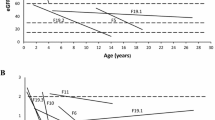Abstract
Background
Since the diverse manifestations of renal impairment appear in different periods of Wilson’s disease, misdiagnosis or missed diagnosis is not rare. This study was undertaken to find the clinical features of renal impairment in children with Wilson’s disease or hepatolenticular degeneration (HLD).
Methods
Eighty-five children with HLD who had been treated at our department between January 1991 and June 2006 were retrospectively studied. The clinical data of 25 patients with renal impairment were analyzed.
Results
In the 85 HLD patients, 34 had renal impairment. Nine of the 34 patients with D-penicillamine treatment were excluded. In the remaining 25 patients, 7 had initiated symptoms of renal impairment, 5 of them with edema, 1 with gross hematuria, and 1 with acute hemolysis and acute renal failure. Twelve of the 25 patients had proteinuria, 14 had hematuria, and 5 had both proteinuria and hematuria. Urine glucose was positive in 4 patients, urine N-acetyl-β-D-glucosaminidase (NAG) increased in 5, and urine β2-microglobulin increased in 6. Urine red blood cell (RBC) phase was detected in 7 patients, including glomerular hematuria in 5 patients and non-glomerular hematuria in 2. Blood urea nitrogen and creatinine increased in 1 patient. B-ultrasound revealed bilaterally enlarged kidneys in 3 patients. Kidney biopsy showed diffuse mesangial proliferation and IgA deposit in mesangial region in 1 patient. All of the 25 patients had cornea K-F ring and the level of ceruloplasmin decreased. Six patients had a family history of HLD.
Conclusions
The manifestations of renal impairment with HLD are varied. HLD should be excluded from patients with unexplained renal impairment, while those with HLD should take examinations of the kidney to identify renal impairment. We propose that renal function and urinalysis should be checked regularly in patients receiving treatment of D-penicillamine.
Similar content being viewed by others
References
Medici V, Rossaro L, Sturniolo GC. Wilson disease—a practical approach to diagnosis, treatment and follow-up. Dig Liver Dis 2007;39:601–609.
Prashanth LK, Taly AB, Sinha S, Arunodaya GR, Swamy HS. Wilson’s disease: diagnostic errors and clinical implications. J Neurol Neurosurg Psychiatry 2004;75:907–909.
Kitzberger R, Madl C, Ferenci P. Wilson disease. Metab Brain Dis 2005;20:295–302.
Ferenci P. Wilson’s disease. Clin Gastroenterol Hepatol 2005; 3:726–733.
Schwarzenberg SJ, Sharp HL. Pediatric gastroenterology. Update on metabolic liver disease. Pediatr Clin North Am 1996;43:27–56.
El-Youssef M. Wilson Disease. Mayo Clin Proc 2003;78: 1126–1136.
Sozeri E, Feist D, Ruder H, Scharer K. Proteinuria and other renal functions in Wilson’s disease. Pediatr Nephrol 1997;11: 307–311.
Voskaridou E, Terpos E, Michail S, Hantzi E, Anagnostopoulos A, Margeli A, et al. Early markers of renal dysfunction in patients with sickle cell/beta-thalassemia. Kidney Int 2006;69:2037–2042.
Sarles J, Durand JM, Scheiner C, Picon G. Wilson disease, IgA glomerulonephritis and vascular purpura: an incidental association? Arch Fr Pediatr 1993;50:501–504.
Behrman RE, Kliegman RM, Jenson HB. Nelson Textbook of Pediatrics. Wilson Disease. 16th ed. Philadelphia: W. B. Sounders Company, 2000: 1209.
Gunduz Z, Dusunsel R, Anarat A. Wilson cirrhosis associated with membranoproliferative glomerulonephritis. Nephron 1996;74:497–498.
Nanke Y, Akama H, Terai C, Kamatani N. Rapidly progressive glomerulonephritis with D-penicillamine. Am J Med Sci 2000;320:398–402.
Habib GS, Saliba W, Nashashibi M, Armali Z. Penicillamine and nephrotic syndrome. Eur J Intern Med 2006;17:343–348.
Author information
Authors and Affiliations
Corresponding author
Rights and permissions
About this article
Cite this article
Zhuang, XH., Mo, Y., Jiang, XY. et al. Analysis of renal impairment in children with Wilson’s disease. World J Pediatr 4, 102–105 (2008). https://doi.org/10.1007/s12519-008-0019-5
Received:
Accepted:
Published:
Issue Date:
DOI: https://doi.org/10.1007/s12519-008-0019-5




